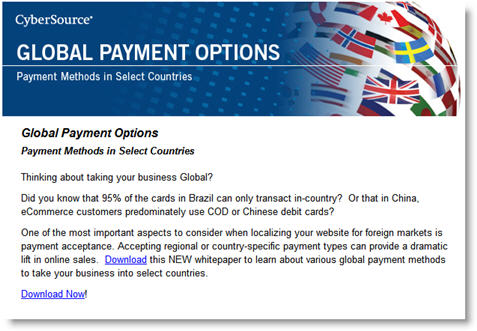If you’re in the, say: Widget Alignment business, you can be forgiven for thinking that your lead generation programs should be laser-focused on finding people who need their widgets aligned. From there, it’s a short and intuitive leap to simply asking people if they need their widgets aligned, or whether they’ve considered the benefits of alignment, so you can help ease their pain.
But what of the people who desperately need their widgets aligned but just don’t know they have the problem? Or those that know they need alignment, but don’t consider it a priority?
My point is this: in lead generation, and in email marketing in particular – don’t ask people if they have the problem you can solve. Just tell them how to solve it.
The problem with asking any kind of Yes/No question in an email is that you put the onus on the reader to decide whether he/she should consider reading further. For example, take the email below from payment processing company Cybersource. Fully half the email copy consists of questions posed to the reader:
• Thinking about taking your business global?
• Did you know that 95% of the cards in Brazil can only transact in-country?
 and so on. The subject line: “Taking Your Business Global?” (not visible here) is a riff on the same theme.
and so on. The subject line: “Taking Your Business Global?” (not visible here) is a riff on the same theme.
Simply put, what if the reader answers “no”? Then you’ve lost him. The much stronger alternative is to flip those questions into action-oriented benefit statements and phrase them in terms of immediate value, for example:
• Now, discover an easy way to take any company global
• Learn how to lift online sales by accepting regional or country-specific payment types
• Download your free report and learn vital information about the most popular payment options worldwide
and so on. Sure, if I’m determined NOT to take my business global, then none of this will be of interest to me regardless. But if I’m on the fence, or if I’ve never considered “expanding globally” per se but could benefit from accepting international payments all the same, then suddenly this is a campaign that resonates.
Remember: don’t ask people whether they need your product or offer. Just tell them what it can do for them.

I don’t disagree with your logic, Howard. A good salesperson never asks a question that might be answered “no” and never asks a question if they aren’t pretty sure how the prospect is going to answer.
That said, you can avoid a rejection by leading with the offer, not the product. Don’t ask people if they want to market overseas (using your example). Instead, lead with the offer of a free report on how to do business overseas. That’s a lot easier to accept and digest.
Thanks for the comment, Otis. I agree wholeheartedly with your suggestion of leading with the offer, but that alone doesn’t mitigate the damage of asking a Yes/No question.
For example, I could ask: “Interested in a free information kit on how to expand your business globally?” and my campaign would still face all the challenges I describe in the post, starting with what happens if the reader answers “no.”
I think it’s an interesting comment above re: yes/no, but you might be asking questions that a person has never considered before… they may not realise how their business/service/lifestyle can be improved or enhanced. That said, a question can be easily re-worded so that it becomes a leading command, e.g. “have you considered…?” can become “consider how…”